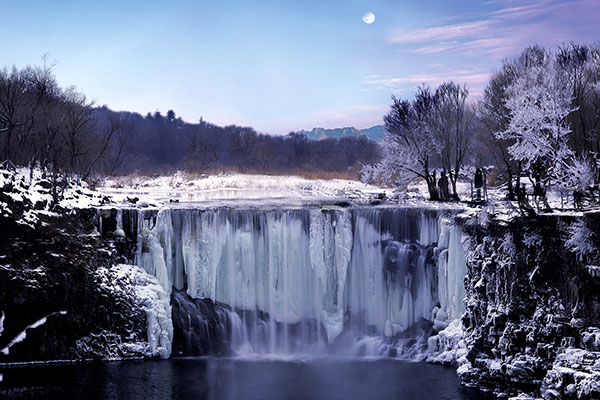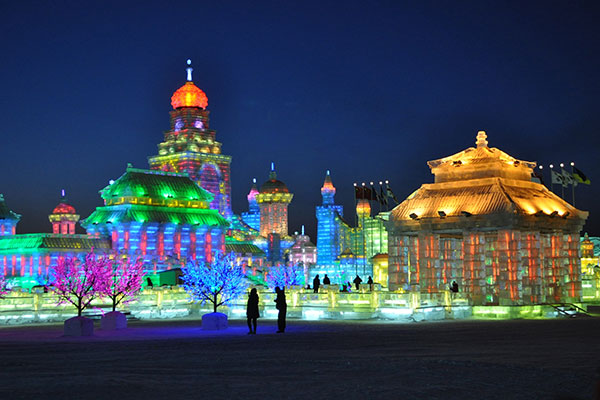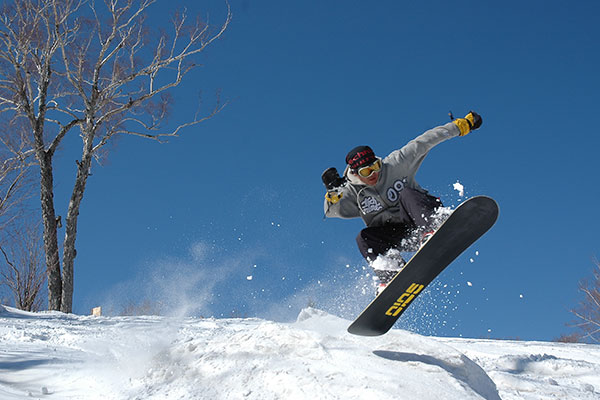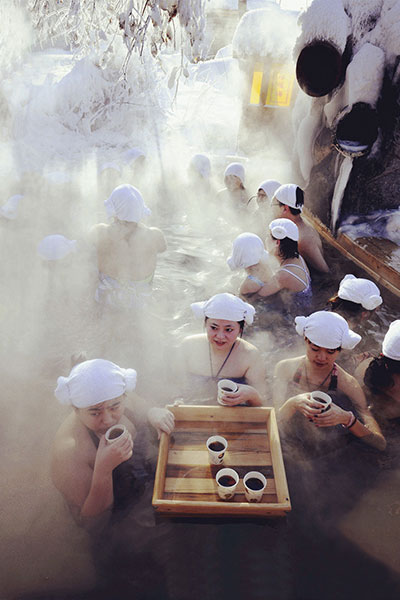
A frozen waterfall in Jingpo Lake.[Photo provided to China Daily]
China’s northernmost province, Heilongjiang, hopes to show how its snow glows and what makes its ice nice through five winter itineraries it announced earlier in November.
Winter tourism is expected to surge this year, following the announcement China will host the 2022 Winter Olympics.
“Ice-and-snow tourism has its own characteristics,” says Zhang Lizhong, head of the China National Tourism Administration’s tourism promotion and international cooperation division.
Visits to Heilongjiang surged during the season last year, but expectations are higher for the 2015-16 winter.
It is, after all, the kind of place Frozen could’ve been set in. Much of it looks like the typical landscapes you’d find in a snow globe.

Ice replicas of ancient palaces and buildings highlight the annual International Ice and Snow Sculpture Festival in Harbin.[Photo provided to China Daily]
The five routes can be booked through China’s major online travel agencies, such as Ctrip, Tuniu and Aoyou.com, an online-booking website under China Youth Travel Service Co.
“We’ve already received many inquiries,” says Huang Lina, product director of CYTS Linkage’s tourism destination marketing department.
Group and individual packages last three to 10 days.
“The bookings usually start in December, after snow falls,” she says.
(Out of sight, out of mind, it seems.)
She expects more people to visit this winter, since another seven promotional events will be staged nationwide in coming months.
Heilongjiang’s unique geology endows it with cool summers and stunning winter scenes forged by copious snow and ice.
Snow falls 120 days a year.

Snowboarding in Yabuli, the largest ski resort in China.[Photo provided to China Daily]
“We blend frozen landscapes with winter activities to ensure unforgettable experiences,” the provincial tourism administration’s head Xi Dongguang says.
China’s winning bid to host the 2022 Winter Games seems likely to expand the number of travelers to the province this season.
President Xi Jinping said more than 300 million Chinese will likely become involved in winter sports, following the announcement.
But Heilongjiang’s winter tourism was heating up before China got the games.
All major sites experienced a 40-65 percent growth in visits last winter, during the period ending Feb 28, 2015, the tourism bureau reports.
(Growth in this year’s first nine months was 22 percent year-on-year. More than 88 million tourists visited.)
There was a positive market response to the winter route the province launched last year that integrates the provincial capital, Harbin; Yabuli, which is known for skiing; and Xuexiang village, where snow buries farmhouses.

Visitors take a hot spring bath in Daqing.[Photo provided to China Daily]
This year, four routes were added to present all of the best Heilongjiang offers.
Harbin, from where all the routes start, has long remained the province’s most popular destination.
The Harbin International Ice and Snow Sculpture Festival creates cities of ice-as in multistory ancient palaces are dwarfed by skyscrapers, all emanating polychromatic glows from within.
The sheer size of some of the buildings makes them more like monuments than mere structures.
(Well, many of them are monuments-or at least ice replicas of them that are close if not to scale. They’re just more stunning rendered in ice with colorful lights shimmering from within.)
And there are, of course, mazes and slides fashioned from ice.
(Wee!)
The festival officially starts on Jan 5 and lasts a month, but sculptures stay until spring ultimately delivers Harbin’s ice world’s annual apocalypse. That can take a while in northernmost China.
Meng Yongning, a resident of Guangzhou, capital of southern China’s steamy Guangdong province, took her 6-year-old to Harbin for five days this January.
“I wanted my girl to see the ice and snow,” she says.
The child hadn’t seen them with her own eyes.
They skied and rode horses on the frozen Songhua River. They wandered among ice sculptures and ice lanterns, and slid down ice chutes at the Harbin Ice and Snow Amusement World.
Meng also enjoyed Central Street, also known as Zhongyang Street. She was impressed by European-style architecture that dates as far back as the 15th century, and especially the Saint Sophia Cathedral.
She plans to visit again this winter.
5 frozen routes
Harbin-Yabuli-Xue-xiang village
Yabuli hosts one of China’s biggest ski resorts.
Visitors can use one card to experience 46 tracks spanning a total 50 kilometers, including three mountains.
It’s best enjoyed from mid-November to late March.
Nearby Xuexiang village also gets seven months of snow. Shutterbugs can snap hundreds of houses buried with white stuff. Locals hang large red lanterns that often give glow to the snow.
Harbin-Daqing-Qiqihar
Daqing is a hot spot for hot springs.
Lianhuanhu offers Mongolian medicine baths. The Beiguo Hot Spring Resort hosts 83 ponds, making it the biggest of its kind in northeastern China.
Qiqihar’s Zhalong nature reserve is home to nine of the world’s 15 crane species, including red-crowned cranes. Winter visitors can watch hundreds of cranes take to the sky over the wetlands.
Longsha Zoological and Botanical Garden houses rare plants and animals from South America and Africa, such as blue wildebeests, zebras and ostriches.
The garden hosts ice sculptures of exotic fauna in winter.
Harbin-Mohe
Mohe is for adventurous types.
It’s the country’s northernmost county and one of its coldest places.
Sunrise comes at 9 am, and sunset arrives by 3 pm.
Beiji village sits a river away from Russia and is an ideal place to see the aurora borealis.
Visitors can experience polar day and night.
Christmas World contains a holiday-themed post office, gift shops and Finnish Santa Clauses. The place blends China’s polar climate with Christmas culture.
Harbin-Mudanjiang
The route offers fishing on the Jingpo Lake and sacrifices before Manchu deities to bless your angling.
Tourists can get a feel for ancient Manchu hunters’ lives.
The Diaoshuilou Waterfall freezes in winter.
Huoshankou national forest park is pocked with craters. Each runs about 100 meters deep and exceeds 100 meters in diameter, and is ringed by primitive forest.
Harbin-Yichun
Yichun is celebrated for its sunrises, rime and giant stone “mushroom” formations. All are striking when blanketed in snow.
White crystals glaze tree branches and stones for four months.
It renders an other world for cross-country skiing, curling or snow soccer.
